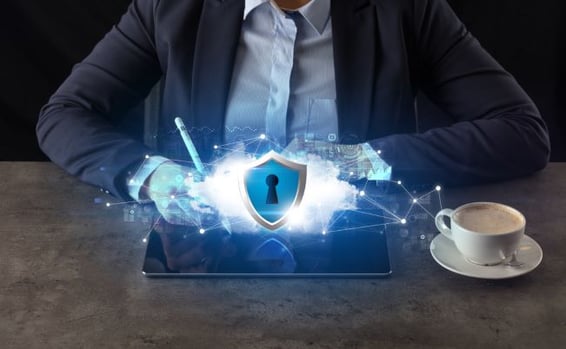Email Security: A Pillar of Cybersecurity You Shouldn't Ignore

December 16, 2022

Since nearly every business has an email system, and the average worker receives many messages daily, emails can serve as a reliable initial infection vector. The overwhelming number of emails can trick employees into thinking they have plenty of time to respond to each one, even though the reality is much different. The vast majority (91%) of cyber-attacks are initiated by email, according to a recent study. Cybercriminals prefer to infiltrate your system and the IT architecture of your business through email.
What is Email Security?

A simple yet concise definition would be the one offered by SafeSend: “Email security is the practice of protecting email accounts and communications from malicious threats.”
In other terms, email security refers to the measures taken to stop cyberattacks and spam sent by email. It includes safeguarding mailboxes against hijacking and domains against spoofing, stopping phishing attacks, preventing fraud, blocking malware from delivery, filtering spam out, and encrypting email content to prevent unauthorized access.
Because the email was created without security and privacy in mind, you must take measures to safeguard your employees' inboxes. Even though email is widely used, security and privacy features are not included by default, making email a common entry point for malicious actors targeting businesses of all sizes and even individuals.
How Criminals Leverage Email
![]()
Criminals use email for various malicious purposes, including gaining access to corporate networks and distributing malware.
Fraud
Business email compromise (BEC) messages target the accounting departments of large enterprises and attempt to deceive them into wiring money to fictitious accounts are just one example of the many types of fraud that may be perpetrated via email. Domain spoofing is a technique used by cybercriminals to make their requests for money appear to come from a trusted organization. While ransomware may get more attention, business email compromise causes more damage. Four years in a row, BEC schemes were the most expensive type of cybercrime reported, with an adjusted loss of around $1.8 billion, according to the FBI Internet Crime Complaint Center (FBI IC3).
Phishing
Attackers in a phishing attempt hope to trick their targets into disclosing personal information. Fraudsters might trick the recipient of a phishing email into providing sensitive information by being forwarded to a spoof website or even only being asked to reply to an email address under the attacker's control with the data. Similar assaults frequently use domain spoofing. The FBI's IC3 2022 Internet Crime Report found that phishing and its variants were responsible for 69.4 percent of all cybercrimes. Since 2020, the number of phishing attacks has multiplied by three.
Malware
Spyware, adware, and ransomware are a few examples of malware spreading via email attachments. According to Verizon's 2022 Data Breach Investigations Report, over 75% of malware is received by the typical company over email. This finding makes email one of the top two delivery mechanisms for dangerous payloads.
Malware can be sent via email in several different methods by attackers. One popular tactic is to embed malware in a file format that appears harmless, such as a PDF or Word document. Both types of files allow for the addition of code, including macros, which attackers can use to download and run malware on the recipient's computer. In recent years, many ransomware infestations have begun with malicious attachments sent by email. Ryuk ransomware, for instance, typically infiltrates a network via a TrickBot or Emotet infection, both propagating via email attachments; similarly, Maze malware also uses this technique to infiltrate a network.
If you add account takeover attacks (ATO) and email interception to the list, you can easily understand why protecting your email is essential for your organization.
Why Email Security is Crucial for Your Business

Business email is used for internal and external communication and is frequently a cornerstone of an organization's IT infrastructure.
If email is compromised, it could severely impact a company's operations. Another significant email risk is spam, which can have severe consequences for a company, like flooding employees' inboxes with irrelevant messages or even leading to phishing scams.
Emails may also contain private information that the intended recipient should only read. This sensitive data could be compromised if emails were not encrypted.
The need for email security is further emphasized by the need to verify the legitimacy of corporate email. As part of a business email compromise (BEC) attack, fraud may occur if an unauthorized user can send emails seeming to come from an official company account.
Why Email Security is a Pillar of Your Cybersecurity Plan

Most businesses today still rely heavily on email to conduct daily operations. As a result, businesses of all sizes can significantly benefit from adopting and implementing email security solutions and best practices.
- Email security helps keep email services online so businesses can stay in touch with their staff and clients.
- Email authentication methods reassure the company employees and its customers that emails from the corporate domain are legitimate.
- Detection and avoidance of fraud. To lessen the likelihood of fraud, businesses must be able to recognize and prevent threats to their email security, such as spoofing.
- Safeguards against malware. The company can lessen the chance of malware infection through email if a sufficient set of security features are available on the email platform.
- Anti-phishing protection. Businesses are vulnerable to phishing attempts because social engineers might trick their employees into sharing sensitive data or downloading malware.
Best Practices for Robust Email Security

It is preferable to have multiple layers of protection regarding email. A single email provider can't counteract every possible danger with built-in controls and protections. Even if an organization already uses a comprehensive email security solution, such as the ones included in Microsoft 365 or Google Workspace, it should add another layer of specialized email security. Professionals in the field use the term "defense-in-depth" to describe this strategy.
Businesses must take a comprehensive approach to email security, including password management, adopting best practices like multi-factor authentication, and providing employees with cyber awareness training. Companies should also employ domain authentication protocols and techniques, such as SPF, DKIM, and DMARC, utilized by reputable email solution providers to prevent domain spoofing and strengthen email security.
When properly implemented, an email security system that integrates with an organization's other systems and processes can help ensure everyone's safety. Although it can be daunting to implement a comprehensive security policy for the company's email, focusing on the basics first could pay dividends in the long run. An organization's inability to protect itself from email-borne threats does not matter how advanced its other security technologies may be.
_________________________________________________________________
About the Author
Anastasios Arampatzis is a retired Hellenic Air Force officer with over 20 years’ worth of experience in managing IT projects and evaluating cybersecurity. Anastasios’ interests include among others cybersecurity policy and governance, ICS and IoT security, encryption, and certificates management. Anastasios has written for many publications and is currently a writer for Bora.
Want to learn more about email security solutions for your business?

Comments